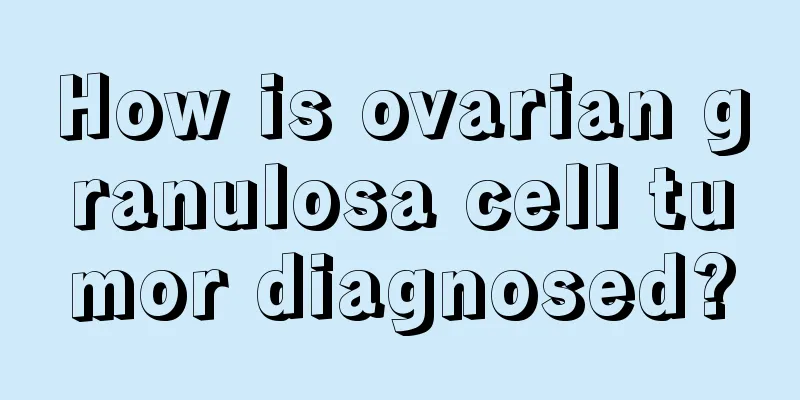How is ovarian granulosa cell tumor diagnosed?

|
In fact, women are very likely to face some gynecological diseases or various reproductive health problems in their daily lives. Because of their special physiological structure, they will be threatened by such diseases as long as they do not pay attention to maintenance in their daily lives. For example, ovarian granulosa cell tumor is a disease that many women are prone to. So now let us take a closer look at the pathological diagnosis of ovarian granulosa cell tumor. Disease diagnosis 1. Adult granular cell tumor and juvenile granular cell tumor. 2. Granular cell tumor, small cell carcinoma and undifferentiated carcinoma The tumor cells of small cell carcinoma and undifferentiated carcinoma are poorly differentiated, and their cell morphology is sometimes very similar to that of granular cell tumor cells, especially when they are diffuse or arranged in a follicular manner. Inexperienced pathologists may make an incorrect diagnosis, which is also an important reason why various hospitals have very different judgments on the malignancy and prognosis of granular cell tumors. Granular cell tumor is significantly different from the latter two in terms of clinical symptoms, signs, and intraoperative exploration. For cases with clinical doubts, collaboration with pathologists should be carried out, specimens should be collected from multiple locations, and new technologies (electron microscopy, immunohistochemistry, etc.) should be applied to make identification possible. 3. Granular cell tumor and other types of sex cord stromal tumors The most common sex cord stromal tumors that are confused with granulosa cell tumors include annular sex cord tumors, supporting cell tumors, and sclerosing stromal tumors. The main reason for misdiagnosis is the lack of familiarity and recognition of the characteristic morphology and structure of these rare tumors. In the past decade or so, domestic and foreign scholars have made a large number of reports on the diagnostic points, morphological characteristics, clinical prognosis, etc. of the above-mentioned rare tumors, and the understanding of these tumors has been significantly improved, which is helpful for differential diagnosis. 4. Granulosa cell tumor and other ovarian tumors that cause clinical endocrine disorders Granulosa cell tumor can cause endocrine disorders in patients and a series of clinical symptoms. However, this feature is not limited to granulosa cell tumors. Some epithelial tumors with luteinized stroma (such as mucinous cystadenoma) may also present symptoms of endocrine disorders. This situation will cause difficulties for clinicians to diagnose. The clinical data should be comprehensively analyzed to differentiate between these two types of tumors. There are obvious differences in the scope of surgery, postoperative treatment, and prognosis between benign epithelial tumors and granular cell tumors abroad. Only by understanding this common sense scientifically can we remind ourselves to take more effective preventive measures in our lives, reduce the occurrence of this disease, and the harm it causes to the body. Therefore, no matter who you are, you should not ignore this common sense. Caring for your own health is also a responsibility that everyone must take. |
<<: Causes of uterine bleeding
>>: What are the signs of adequate milk supply?
Recommend
How to calculate ovulation? B-ultrasound is the most accurate way to monitor ovulation
In order to get pregnant, many female friends wil...
What causes needle-like pain in breasts?
Nowadays, many women are prone to gynecological d...
The worst symptoms of menopause
The menopause issue has always been a topic that ...
Bleeding in the stool before menstruation
Many girls will experience some changes in their ...
Canalys: Apple's shipments in China grew 17% in Q2 2023
China recently announced a ban on all central gov...
The probability of wisdom tooth inflammation during pregnancy
If a pregnant woman has impacted wisdom teeth in ...
Which group of people are prone to breast disease?
Women's health experts say that the incidence...
What is the cause of bleeding after ectopic pregnancy surgery?
Do you know about ectopic pregnancy? Do you know ...
How long does it take for hcg to be metabolized?
Many people find that the hcg level in their bloo...
How to braid your hair to look simple and beautiful
Braiding hair is a very common thing. Many women ...
Can pregnant women drink Yakult?
Yakult is a yogurt drink with relatively high nut...
[Medical Q&A] Can tophi grow in the ears?
Planner: Chinese Medical Association Reviewer: Sh...
Can I still get pregnant after 3 abortions?
Many women become pregnant without any precaution...
Why do I feel back pain after having an abortion?
Young women nowadays are too young and have no aw...









